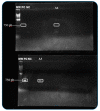Leishmania V. braziliensis infection in asymptomatic domestic animals within an endemic region in the Northeast of Brazil
- PMID: 35976338
- PMCID: PMC9405948
- DOI: 10.1590/0037-8682-0600-2021
Leishmania V. braziliensis infection in asymptomatic domestic animals within an endemic region in the Northeast of Brazil
Abstract
Background: American cutaneous leishmaniasis is a commonly neglected, vector-borne tropical parasitic disease that is a major public health concern in Brazil. Leishmania (Viannia) braziliensis is the main species associated with the disease. Accurate diagnosis is based on epidemiological surveillance, clinical assessment, and laboratory testing. Leishmania (V.) braziliensis has been detected in several wild and synanthropic mammals. Their epidemiological role has not been entirely elucidated. This study aimed to assess potential L. braziliensis infections in asymptomatic domestic animals, by molecular and serological testing in endemic areas, in the metropolitan region of Recife.
Methods: Blood samples and conjunctival fluids were collected from 232 animals (canids, felids, equines, and caprines) for the detection of L. braziliensis using molecular tests (conventional and real-time polymerase chain reaction [PCR and qPCR]). For immunological detection, blood samples from 115 dogs were assessed using enzyme-linked immunosorbent assay.
Results: Real-time quantitative PCR showed positive results for blood and conjunctival samples in all investigated species. The results of the blood and conjunctival samples were 68.2% and 26.9% in Canis familiaris, 100% and 41.7% in Felis catus, 77.3% and 30.8% in Equus caballus/Equus asinus, and 50% and 33.3% in Capra hircus samples, respectively.
Conclusions: Results from this study adds valuable information to our understanding of the role of asymptomatic domestic animals, L. braziliensis life cycle, and American cutaneous leishmaniasis in Northeast Brazil.
Conflict of interest statement
Figures





Similar articles
-
High levels of infectiousness of asymptomatic Leishmania (Viannia) braziliensis infections in wild rodents highlights their importance in the epidemiology of American Tegumentary Leishmaniasis in Brazil.PLoS Negl Trop Dis. 2023 Jan 30;17(1):e0010996. doi: 10.1371/journal.pntd.0010996. eCollection 2023 Jan. PLoS Negl Trop Dis. 2023. PMID: 36716345 Free PMC article.
-
Epidemiological aspects of vector, parasite, and domestic reservoir in areas of recent transmission and no reported human cases of visceral leishmaniasis in Brazil.Acta Trop. 2015 Aug;148:128-36. doi: 10.1016/j.actatropica.2015.04.002. Epub 2015 Apr 14. Acta Trop. 2015. PMID: 25882769
-
Wild, synanthropic and domestic hosts of Leishmania in an endemic area of cutaneous leishmaniasis in Minas Gerais State, Brazil.Trans R Soc Trop Med Hyg. 2011 Oct;105(10):579-85. doi: 10.1016/j.trstmh.2011.07.005. Epub 2011 Sep 3. Trans R Soc Trop Med Hyg. 2011. PMID: 21890159
-
Assessing reservoir host status in leishmaniasis with special reference to the infectiousness of Leishmania (Viannia) braziliensis infections in wild rodents.Rev Soc Bras Med Trop. 2023 Dec 15;56:0503. doi: 10.1590/0037-8682-0503-2023. eCollection 2023. Rev Soc Bras Med Trop. 2023. PMID: 38126376 Free PMC article. Review.
-
The role of dogs as reservoirs of Leishmania parasites, with emphasis on Leishmania (Leishmania) infantum and Leishmania (Viannia) braziliensis.Vet Parasitol. 2007 Nov 10;149(3-4):139-46. doi: 10.1016/j.vetpar.2007.07.007. Epub 2007 Aug 20. Vet Parasitol. 2007. PMID: 17703890 Review.
Cited by
-
qPCR as a Tool for the Diagnosis of Visceral and Cutaneous Leishmaniasis: A Systematic Review and Meta-Analysis.Acta Parasitol. 2025 Jan 7;70(1):16. doi: 10.1007/s11686-024-00942-8. Acta Parasitol. 2025. PMID: 39777570
-
A Virtual Screening Approach to Evaluate the Multitarget Potential of a Chalcone Library with Binding Properties to Oligopeptidase B and Cysteine Proteinase B from Leishmania (Viannia) braziliensis.Int J Mol Sci. 2025 Feb 26;26(5):2025. doi: 10.3390/ijms26052025. Int J Mol Sci. 2025. PMID: 40076645 Free PMC article.
-
First report of Leishmania (Mundinia) martiniquensis in South American territory and confirmation of Leishbunyavirus infecting this parasite in a mare.Mem Inst Oswaldo Cruz. 2023 May 15;118:e220220. doi: 10.1590/0074-02760220220. eCollection 2023. Mem Inst Oswaldo Cruz. 2023. PMID: 37194810 Free PMC article.
References
-
- Shaw JJ, Lainson R. Ecology and epidemiology. Vol. 1. New World: Academic Press; 1987. pp. 291–363.
-
- Schwartz E, Hatz C, Blum J. New world cutaneous leishmaniasis in travellers. Lancet Infect Dis. 2006;6(6):342–349. - PubMed
-
- Ruiz-Postigo JA, Jain S, Mikhailov A, Maia-Elkhoury AN, Valadas S, Warusavithana S, et al. Global leishmaniasis surveillance: 2019-2020, a baseline for the 2030 roadmap/Surveillance mondiale de la leishmaniose: 2019-2020, une periode de reference pour la feuille de route a l'horizon 2030. Wkly Epidemiol Rec. 2021;96(35):401–419.
-
- Brilhante AF, Souza AI, Dorval MEC, França AO, Lima RB, Galati EAB, et al. Canine cutaneous leishmaniasis by Leishmania (Viannia) braziliensis in an agricultural settlement, endemic area for leishmaniasis. Arq Bras Med Vet Zootec. 2016;68(04):927–930.
MeSH terms
LinkOut - more resources
Full Text Sources

